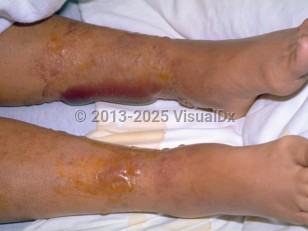Potentially life-threatening emergency
Vibrio vulnificus infection
See also in: Cellulitis DDxAlerts and Notices
Important News & Links
Synopsis

Emergent Care / Stabilization:
Patients may present with primary septicemia, and one-third may present with shock or develop shock during the first 12 hours of hospitalization. Given the high mortality rate in septicemia, patients should be admitted to an intensive care unit (ICU) and treated with both IV antibiotics and aggressive IV hydration.
Diagnosis Overview:
Vibrio vulnificus is a virulent, gram-negative rod that can cause wound infections and primary septicemia. Vibrio vulnificus is endemic to the coast of the Gulf of Mexico, the Chesapeake Bay, and, to a lesser extent, the Atlantic and Pacific coasts of North America and Northern Europe. Vibrio vulnificus is rarely detected in water colder than 13 °C (55.4 °F); thus, most infections in the United States occur between the months of May and October during warmer water temperatures.
Vibrio vulnificus infection is most commonly seen in men older than 40 years. Infection is contracted through sustaining a new scratch, inoculation of a preexisting wound, or through ingestion of raw shellfish such as raw oysters (V vulnificus is found in up to 10% of raw shellfish on the market in the United States). It is generally acquired in coastal areas (particularly the Gulf Coast) where it is part of the normal flora of seawater from warmer climates.
Vibrio vulnificus infection may manifest clinically in 3 distinct presentations: direct skin infection, primary septicemia, or gastrointestinal illness. The infection may be acquired via direct inoculation of the skin or enterally after ingestion of contaminated raw oysters / seafood.
In the case of direct skin infection, cutaneous lesions develop at the site of a new or prior wound and can spread rapidly, varying in severity from a mild cellulitis to a life-threatening soft tissue infection, including myositis and necrotizing fasciitis. A characteristic skin finding is the development of hemorrhagic bullae with cellulitis. Tenosynovitis can occur after a laceration. If infection occurs after ingestion of bacteria, vomiting or a diarrheal illness may ensue. Of the patients presenting with primary septicemia, one-third are in septic shock or develop shock during the first 12 hours of hospitalization (primary bacteremic vibriosis). In these patients, skin lesions may develop in the first 24 hours. Risk factors for severe V vulnificus infection include preexisting liver disease, in particular alcoholic liver disease and hemochromatosis, and a subset of chronic medical diseases, including lymphoma, rheumatoid arthritis, chronic renal failure, and diabetes mellitus. Mortality for primary V vulnificus septicemia with hypotension is approximately 50%, and amputation results in 10% of cases.
Patients may present with primary septicemia, and one-third may present with shock or develop shock during the first 12 hours of hospitalization. Given the high mortality rate in septicemia, patients should be admitted to an intensive care unit (ICU) and treated with both IV antibiotics and aggressive IV hydration.
Diagnosis Overview:
Vibrio vulnificus is a virulent, gram-negative rod that can cause wound infections and primary septicemia. Vibrio vulnificus is endemic to the coast of the Gulf of Mexico, the Chesapeake Bay, and, to a lesser extent, the Atlantic and Pacific coasts of North America and Northern Europe. Vibrio vulnificus is rarely detected in water colder than 13 °C (55.4 °F); thus, most infections in the United States occur between the months of May and October during warmer water temperatures.
Vibrio vulnificus infection is most commonly seen in men older than 40 years. Infection is contracted through sustaining a new scratch, inoculation of a preexisting wound, or through ingestion of raw shellfish such as raw oysters (V vulnificus is found in up to 10% of raw shellfish on the market in the United States). It is generally acquired in coastal areas (particularly the Gulf Coast) where it is part of the normal flora of seawater from warmer climates.
Vibrio vulnificus infection may manifest clinically in 3 distinct presentations: direct skin infection, primary septicemia, or gastrointestinal illness. The infection may be acquired via direct inoculation of the skin or enterally after ingestion of contaminated raw oysters / seafood.
In the case of direct skin infection, cutaneous lesions develop at the site of a new or prior wound and can spread rapidly, varying in severity from a mild cellulitis to a life-threatening soft tissue infection, including myositis and necrotizing fasciitis. A characteristic skin finding is the development of hemorrhagic bullae with cellulitis. Tenosynovitis can occur after a laceration. If infection occurs after ingestion of bacteria, vomiting or a diarrheal illness may ensue. Of the patients presenting with primary septicemia, one-third are in septic shock or develop shock during the first 12 hours of hospitalization (primary bacteremic vibriosis). In these patients, skin lesions may develop in the first 24 hours. Risk factors for severe V vulnificus infection include preexisting liver disease, in particular alcoholic liver disease and hemochromatosis, and a subset of chronic medical diseases, including lymphoma, rheumatoid arthritis, chronic renal failure, and diabetes mellitus. Mortality for primary V vulnificus septicemia with hypotension is approximately 50%, and amputation results in 10% of cases.
Codes
ICD10CM:
A05.5 – Foodborne Vibrio vulnificus intoxication
B96.82 – Vibrio vulnificus as the cause of diseases classified elsewhere
SNOMEDCT:
402965002 – Vibrio vulnificus infection
414286000 – Food poisoning caused by Vibrio vulnificus
A05.5 – Foodborne Vibrio vulnificus intoxication
B96.82 – Vibrio vulnificus as the cause of diseases classified elsewhere
SNOMEDCT:
402965002 – Vibrio vulnificus infection
414286000 – Food poisoning caused by Vibrio vulnificus
Look For
Subscription Required
Diagnostic Pearls
Subscription Required
Differential Diagnosis & Pitfalls

To perform a comparison, select diagnoses from the classic differential
Subscription Required
Best Tests
Subscription Required
Management Pearls
Subscription Required
Therapy
Subscription Required
References
Subscription Required
Last Reviewed:01/24/2024
Last Updated:02/29/2024
Last Updated:02/29/2024
Potentially life-threatening emergency
Vibrio vulnificus infection
See also in: Cellulitis DDx
